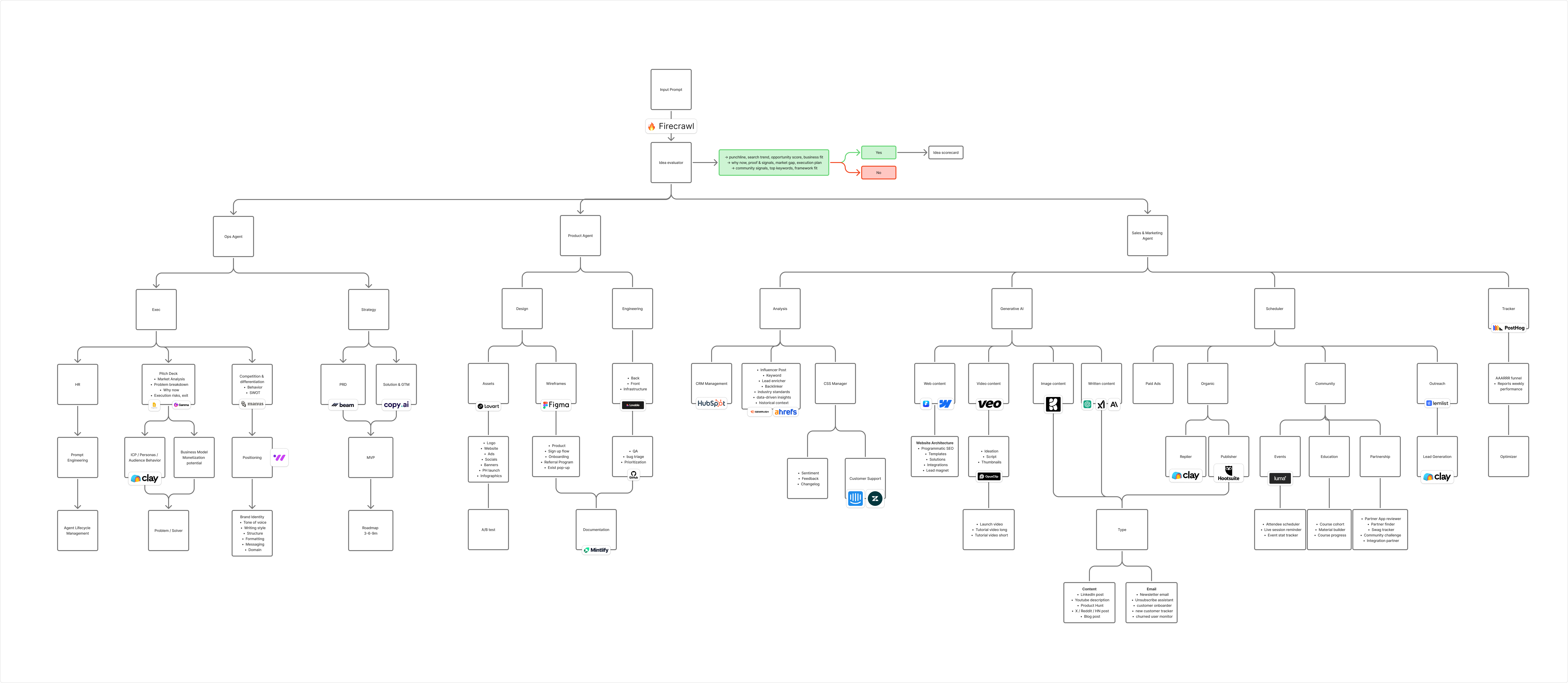12 min
Most AI agents today are toys. One-shot prompt-chains pretending to be workflows.
Agent Organization flips that. Instead of single-task LLM calls, think multi-agent orchestration. Agent ops. Agent lifecycle. Roles. Memory. Context sharing. Approval gates. Org charts made of agents.
This isn’t sci-fi. It’s being built right now—prompt to organization. An idea goes in. A full business comes out:
- Research agent pulls ICPs and competitors.
- Strategy agent drafts the business model and positioning.
- Execution agent creates the MVP roadmap, PRD, and GTM.
- Design and marketing agents spin up landing pages and brand assets.
Each is an autonomous node with shared context and human approval checkpoints.
Why now? Because workflows are broken. No-code tools are clunky. Code is overkill. Agent organizations are the interface between messy human intent and structured software automation. It’s not about building agents. It’s about building agent teams.
This is the new API layer. The OS of work. And it’s here.
I Hired 33 AI Agents: Here’s How I Automated My Entire Organization
Most people build companies by hiring people.
I did the opposite. I built a full-stack organization using nothing but AI agents.
After months of trial, error, and integration headaches, I finally structured my AI workforce into a functional, scalable org chart—33 agents strong. No fluff. Just pure execution.
Today, this system allows me to run what feels like a 10-person marketing team, solo. Here’s how I pulled it off—and what I learned the hard way.
The Setup: Org Chart of the Future
At the top, I sit as the founder. Below me, a single Executive Director AI routes tasks, pings me on WhatsApp/Slack, and oversees the entire operation. Each team has a manager agent—one layer below the director—who selects the right AI for the job and handles reporting.
The org is split into 8 teams:
- Content (Ideation, repurposing, post writing)
- Comms (Email, Slack, Calendar, DMs)
- Sales (Lead gen, research, CRM)
- Outbound (Copy, intent, cold outreach)
- Research (General research, swipe files, GTM strategy)
- Marketing (Ad design, analytics)
- Projects (Notion, GDrive)
- Executive (Coordination, decision support)
Each team runs independently, but everything ties together through the Executive Director AI that acts like a COO. The speed is insane.
What’s Working
- Social media marketing (X, LinkedIn)
- SEO (Top performing channel)
- Sponsorships
- Influencer marketing
After getting burned hiring a marketer who was poached by a competitor, I took over my own brand. I tweet daily. The results? Explosive. Organic distribution is compounding.
I ignored SEO for too long. Since April 2023, I’ve gone all in—automated blog posts (SeobotAI), mini tools (Wrapifai), manual tuning on winners. SEO is now my growth machine.
Teachers, hackathons, and niche web directories. All cheap, scalable, and shockingly effective. Sponsorships outperformed paid ads by a mile.
It works—if the influencer is real. ROI is solid on the legit ones. I pay $100–$1,000 per post depending on reach. Don’t waste time with anyone who bought followers.
What I Killed
- Partnerships with incubators
- Paid Ads (Google, Meta, Reddit, etc.)
- Newsletters, banner ads, Product Hunt promos
- Conferences and Speaking
- My Podcast
- Cross-promo with founders
Looked good on paper. In reality: zero users, zero revenue. Canceled all deals. Waste of time and goodwill.
Total sinkhole. Bots, junk traffic, low intent. I lost thousands. Now I only run ads on my own network, TinyAdz.com, and cap ad spend at 5% of profit.
Terrible ROI. High CPM, zero conversion. Banner ads especially—pure burn. Won’t touch these again.
Great for ego, bad for CAC. I only do it now when it’s virtual and high leverage.
Burned $40k building a podcast brand. Result? Burnout. If you don’t love video calls, don’t even start. Not worth the energy.
Founders suck at collaborating. Egos everywhere. The only good deal? HuntedSpace. Everything else flopped.
How AI Makes This Work
This isn't just “use ChatGPT for writing.” Every agent is trained on a specific role, scoped tightly, and plugged into tools and automations. Examples:
- My LinkedIn Post Writer takes in content themes, formats tone, schedules it.
- My Outbound Copywriter parses signal from the Intent Analyst, writes sequences.
- My Content Repurposer turns a YouTube transcript into a blog, newsletter, and LinkedIn thread—hands-free.
- Notion Assistant maintains internal docs; GDrive Assistant organizes files by project.
Each agent is replaceable. No HR, no churn, no offboarding. I tweak, retrain, or delete.
Final Thoughts
AI doesn’t replace your vision. It replaces the drag between your idea and the market.
If you’re a solo founder, forget building a “team.” Build an army of agents. Start small, automate one function. Then another. Then everything.
My team of 33 AI agents is just the beginning.

